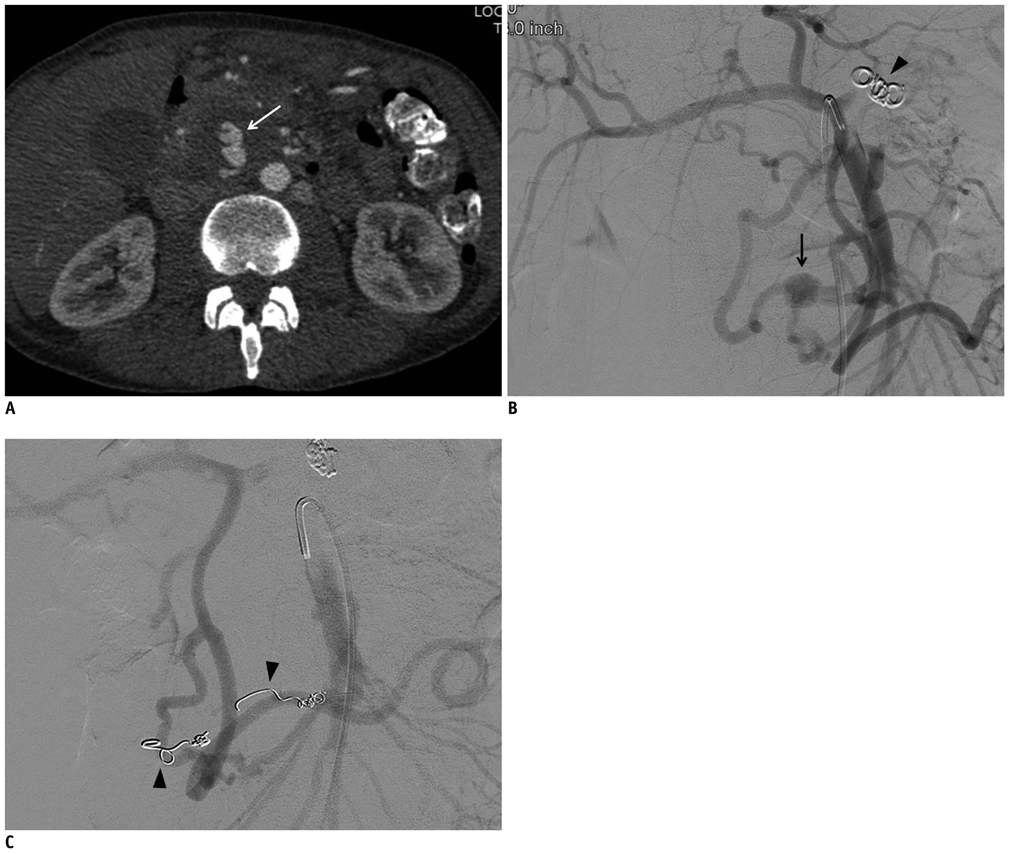Korean J Radiol.
2012 Feb;13(Suppl 1):S45-S55. 10.3348/kjr.2012.13.S1.S45.
Vascular Complications of Pancreatitis: Role of Interventional Therapy
- Affiliations
-
- 1Diagnostic and Interventional Radiology at University of Texas Health Science Center at San Antonio, San Antonio, Tx 78249, USA. BARGE@UTHSCSA.EDU
- 2Vascular and Interventional Radiology at University of Texas Health Science Center at San Antonio, San Antonio, Tx 78249, USA.
- KMID: 1372867
- DOI: http://doi.org/10.3348/kjr.2012.13.S1.S45
Abstract
- Major vascular complications related to pancreatitis can cause life-threatening hemorrhage and have to be dealt with as an emergency, utilizing a multidisciplinary approach of angiography, endoscopy or surgery. These may occur secondary to direct vascular injuries, which result in the formation of splanchnic pseudoaneurysms, gastrointestinal etiologies such as peptic ulcer disease and gastroesophageal varices, and post-operative bleeding related to pancreatic surgery. In this review article, we discuss the pathophysiologic mechanisms, diagnostic modalities, and treatment of pancreatic vascular complications, with a focus on the role of minimally-invasive interventional therapies such as angioembolization, endovascular stenting, and ultrasound-guided percutaneous thrombin injection in their management.
MeSH Terms
-
Diagnostic Imaging
Embolization, Therapeutic/methods
Hemostasis, Endoscopic
Hemostatics/administration & dosage
Humans
Pancreatitis/*complications
Stents
Thrombin/administration & dosage
Ultrasonography, Interventional
Vascular Diseases/diagnosis/*etiology/physiopathology/*therapy
Vascular Surgical Procedures/*methods
Figure
Reference
-
1. Affronti J. Chronic pancreatitis and exocrine insufficiency. Prim Care. 2011. 38:515–537. ix2. Whitcomb DC. Clinical practice. Acute pancreatitis. N Engl J Med. 2006. 354:2142–2150.3. Balthazar EJ. Acute pancreatitis: assessment of severity with clinical and CT evaluation. Radiology. 2002. 223:603–613.4. Flati G, Andrén-Sandberg A, La Pinta M, Porowska B, Carboni M. Potentially fatal bleeding in acute pancreatitis: pathophysiology, prevention, and treatment. Pancreas. 2003. 26:8–14.5. Sharma PK, Madan K, Garg PK. Hemorrhage in acute pancreatitis: should gastrointestinal bleeding be considered an organ failure? Pancreas. 2008. 36:141–145.6. Bergert H, Dobrowolski F, Caffier S, Bloomenthal A, Hinterseher I, Saeger HD. Prevalence and treatment of bleeding complications in chronic pancreatitis. Langenbecks Arch Surg. 2004. 389:504–510.7. Yekebas EF, Wolfram L, Cataldegirmen G, Habermann CR, Bogoevski D, Koenig AM, et al. Postpancreatectomy hemorrhage: diagnosis and treatment: an analysis in 1669 consecutive pancreatic resections. Ann Surg. 2007. 246:269–280.8. Izaki K, Yamaguchi M, Kawasaki R, Okada T, Sugimura K, Sugimoto K. N-butyl cyanoacrylate embolization for pseudoaneurysms complicating pancreatitis or pancreatectomy. J Vasc Interv Radiol. 2011. 22:302–308.9. Andersson E, Ansari D, Andersson R. Major haemorrhagic complications of acute pancreatitis. Br J Surg. 2010. 97:1379–1384.10. Iwama Y, Sugimoto K, Zamora CA, Yamaguchi M, Tsurusaki M, Taniguchi T, et al. Transcatheter embolization of splenic artery pseudo-aneurysm rupturing into colon after post-operative pancreatitis. Cardiovasc Intervent Radiol. 2006. 29:133–136.11. Charvat F, Maskova J, Belina F, Buric I, Lacman J, Fuksa Z, et al. Portal vein erosion: a rare hemorrhagic complication of acute pancreatitis treated by percutaneous stent-graft placement. J Vasc Interv Radiol. 2010. 21:411–412.12. Lee KM, Paik CN, Chung WC, Yang JM. Association between acute pancreatitis and peptic ulcer disease. World J Gastroenterol. 2011. 17:1058–1062.13. Saad NE, Saad WE, Davies MG, Waldman DL, Fultz PJ, Rubens DJ. Pseudoaneurysms and the role of minimally invasive techniques in their management. Radiographics. 2005. 25:Suppl 1. S173–S189.14. Balachandra S, Siriwardena AK. Systematic appraisal of the management of the major vascular complications of pancreatitis. Am J Surg. 2005. 190:489–495.15. Hsu JT, Yeh CN, Hung CF, Chen HM, Hwang TL, Jan YY, et al. Management and outcome of bleeding pseudoaneurysm associated with chronic pancreatitis. BMC Gastroenterol. 2006. 6:3.16. Harvey J, Dardik H, Impeduglia T, Woo D, DeBernardis F. Endovascular management of hepatic artery pseudoaneurysm hemorrhage complicating pancreaticoduodenectomy. J Vasc Surg. 2006. 43:613–617.17. Zyromski NJ, Vieira C, Stecker M, Nakeeb A, Pitt HA, Lillemoe KD, et al. Improved outcomes in postoperative and pancreatitis-related visceral pseudoaneurysms. J Gastrointest Surg. 2007. 11:50–55.18. Udd M, Leppäniemi AK, Bidel S, Keto P, Roth WD, Haapiainen RK. Treatment of bleeding pseudoaneurysms in patients with chronic pancreatitis. World J Surg. 2007. 31:504–510.19. Francisco LE, Asunción LC, Antonio CA, Ricardo RC, Manuel RP, Caridad MH. Post-traumatic hepatic artery pseudoaneurysm treated with endovascular embolization and thrombin injection. World J Hepatol. 2010. 2:87–90.20. Dambrin C, Marcheix B, Birsan T, Cron C, Muscari F, Suc B, et al. Posttraumatic pseudoaneurysm of the hepatic artery: treatment with ultrasound-guided percutaneous transhepatic thrombin injection. J Trauma. 2005. 59:239–242.21. Sparrow P, Asquith J, Chalmers N. Ultrasonic-guided percutaneous injection of pancreatic pseudoaneurysm with thrombin. Cardiovasc Intervent Radiol. 2003. 26:312–315.22. Bender JS, Bouwman DL, Levison MA, Weaver DW. Pseudocysts and pseudoaneurysms: surgical strategy. Pancreas. 1995. 10:143–147.23. Lopera JE. Embolization in trauma: principles and techniques. Semin Intervent Radiol. 2010. 27:14–28.24. Sanada Y, Kondo H, Goshima S, Kanematsu M, Tanaka Y, Tokuyama Y, et al. Liver abscess after common hepatic artery embolization for delayed hemorrhage following pancreaticoduodenectomy: a case report. Case Report Med. 2010. 2010:280430.25. Madoff DC, Denys A, Wallace MJ, Murthy R, Gupta S, Pillsbury EP, et al. Splenic arterial interventions: anatomy, indications, technical considerations, and potential complications. Radiographics. 2005. 25:Suppl 1. S191–S211.







